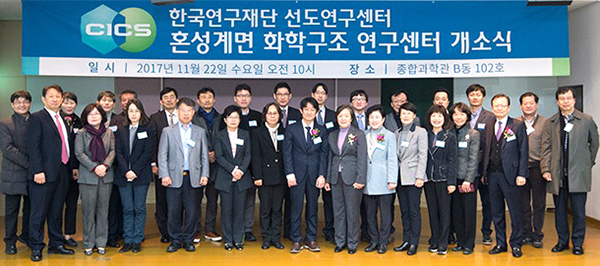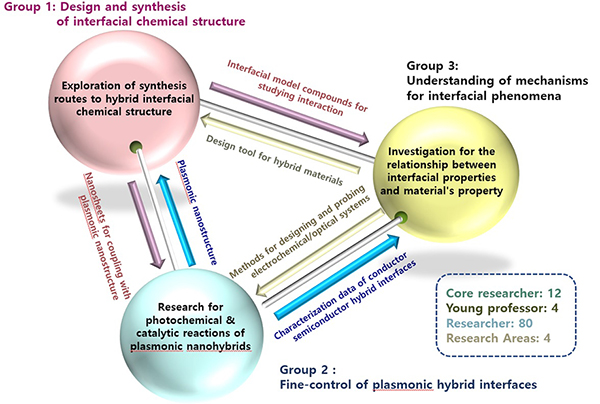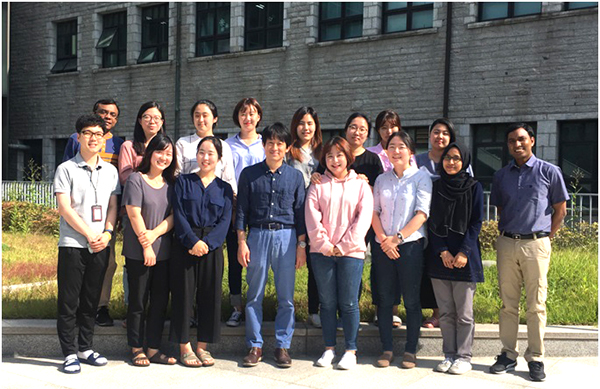본문
Center for Hybrid Interfacial Chemical Structure (CICS)
A. Purpose
The Center for Hybrid Interfacial Chemical Structure was established in order to investigate the mechanism of interfacial phenomena—a current scientific conundrum—such as electronic structure coupling, interfacial bond formation and charge transfer among inorganic nanostructures, polymers and molecular substances, and to present theories of interfacial phenomena, thereby understanding the relationship between hybrid interfacial phenomena and the manifestation of their physicochemical properties. Based on this understanding, it also aims to design energy and nano-bio functional compounds through the hybridization of more than two substances, develop methods to synthesize them, present new research methodologies on materials chemistry, and encourage follow-up studies.
B. Background
There are currently active efforts across the world in terms of the research on nanostructured compounds, which manifest various physicochemical properties and functionalities through the manipulation of their structures and morphologies. In particular, the research on synthesizing new materials has expanded exponentially, seeking ways to hybridize more than two compounds in order to overcome limitations in controlling physical properties and optimizing the functionalities of existing single-component compounds. However, such research efforts are generally focused on performance improvement by mixing existing compounds using Edisonian methods, rather than designing new compounds or synthesis research based on fundamental theories of compound design. In order to overcome the limitations of existing studies, it is essential to conduct basic research that suggests methods to synthesize energy functional compounds through the prediction of chemical structures and identification of the molecular-level mechanism in hybrid surfaces, based on the prediction and design methods of physical property-specific energy-functional hybrid compounds through multi-scale prediction and informatization of materials whose mechanism is identified at the atomic level.

C. Role of each organization
All members of the CICS are experts in the fields of nanochemistry, inorganic chemistry, polymer chemistry and physical chemistry, with world-class research capabilities and experiences of multiple years, particularly in fields such as synthesis, application, measurement and theoretical research. The CICS is among the greatest groups of experts in Korea and continues to publish papers in world-renowned academic journals. All members engage in individual research on interfacial phenomena based on an understanding of the increasingly important role of interfaces at the nano level and the recognition of interfaces as an element may generate new, peculiar physical properties.

Group I at the CICS pursues research on syntheses of two-dimensional inorganic nanosheets, bio-mimetic molecules, conductive polymers, etc., based on the mechanism of interfacial phenomena and their energy storage functionalities and the optimization of their physical properties. Group II explores the syntheses of plasmonic nanostructures and their hybrids with semi-conductors and the development of energy-conversion compounds for solar, electric and chemical energy and photonic nano-bio compounds. Group III presents the prediction and design methods of physical property-specific energy-functional hybrid compounds through multi-scale prediction and the informatization of materials whose mechanism is identified at the atomic level. Based on the prediction and design methods presented by Group III, Groups I and II conduct research on the syntheses of functional molecular substances and functionality optimization. Through such collaborative research among the three groups, the CICS aims to identify the relationship between coupling and physicchemical properties, and carry out research on the design and development of fundamental energy-functional compounds, going beyond the existing Edisonian synthesis methods.
With regards to the cooperation between Groups I and III, Group III presents interfacial research methodology between inorganic nanocompounds and bio-mimetic molecules, and between carbon and polymer compounds, while Group I designs and synthesizes materials based on the aforementioned methodology. Furthermore, in order to understand the properties of hybrid compounds synthesized by Group I and thereby optimize the compounds, Group III calculates the electronic structures and chemical bonding properties, examines the basic properties of compounds synthesized by Group I using spatiotemporal spectroscopy and a liquefied electron microscope, and builds a feedback system to complement theoretical models using the secured data.
Regarding cooperation between Groups II and III, Group III presents theoretical predictions of the combination of semiconductors and plasmonic nanostructures, which enables the maximization of the absorption and conversion efficiency of solar energy. Based on these predictions, Group II develops energy-conversion hybrid compounds. Likewise, Group III explores peculiar basic properties of compounds developed by Group II using a measurement method of energy dynamics, and subsequently provides its counterpart group with complemented models and theories to identify the relevant phenomena.
Compounds produced by Groups I and II are multi-functional materials that can be mutually and simultaneously traded as electrodes, smart electrolyte compounds, high-conductive plasmonic nanostructures and photocatalysts. New methods of designing and synthesizing materials are developed by trading information on newly-developed compounds. The identified hybrid materials transform solar energy to electrical energy by combining secured energy-conversion functional compounds and energy-storage functional compounds.

Director of CICS : Prof. Seong-Ju Hwang in the Department of Chemistry and Nanoscience
· http://home.ewha.ac.kr/~anl21/













